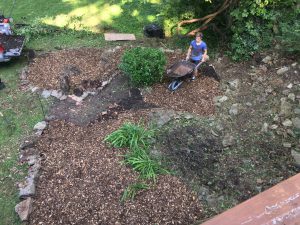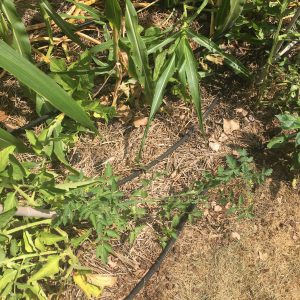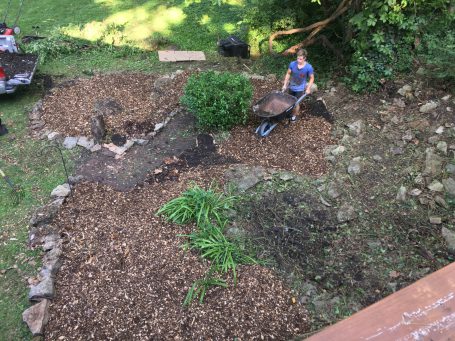Three Ways to Improve Garden Soil
One of the main ideals of Permaculture is to catch and store energy in whichever form it takes. Most people spend heaps of cash importing what they need and disposing of their waste, when if they only examined their system a little, they would discover that what they pay the trash collector to take away is actually a valuable resource if harnessed and stored correctly. This is problem of biological waste is often an opportunity to improve garden soil. The ideal system is one in which no “waste” is produced; every byproduct of every element is captured and channeled to some other purpose. In essence, we capture the waste (aka. sink) of one system in order to feed another. Of course, this is physically impossible per Newton’s laws of thermodynamics, but for the practical purposes of everyday life, we can actually come quite close. So, let’s just get real – how do you find cheep and easy ways to improve your garden soil?
1 – Kitchen Compost
This is probably the best understood method for recycling resources, but surprisingly few people actually do it. If we are honest, the few that do compost, never actually get to use what they create because it’s in a forgotten corner of the yard. Whether from fear of the smells and sights of rotting vegetables or merely the inconvenience of gathering scraps and toting them to the compost pile, most people miss out on this simple and productive system. It does take a bit more work, but for a serious gardener it is more than worth it as piles of fertile earth become available.
You can compost vegetable and fruit scraps, eggshells and coffee grounds (in moderation), however meats, dairy and fats should be avoided as they will stink and attract pests. Unless, of course, you are using the Berkley Method of Composting, but that’s another article.
Where heat and moisture are concerned, the microorganisms that make compost have a goldilocks zone: warm and moist. Accordingly, if you live in a cold climate it is best to have the compost in the sun where the microorganisms can benefit from the heat, but if you live in a hot climate, you may want to put your compost in partial shade as too much heat will hamper the process or cause it to go anaerobic. If you live in a dry climate, you will also need to watch the moisture; a dry compost will not only kill microorganisms, but if overheated may actually catch on fire.
Compost should be turned regularly to provide oxygen for the microorganisms. This provides the perfect chance to check for moisture and heat. Also, compost should maintain about a 1:2 ratio of brown (leaves, twigs, dried stalks) to green (veggies, fruit, chicken manure), the term ‘brown’ referring to those materials higher in carbon and ‘green’ those higher in nitrogen. A healthy compost needs both. If properly maintained, this ratio should be enough to neutralize any odors coming of your compost. For a chart of compost items on the carbon/nitrogen continuum you can go to homecompostingmadeeasy.com.
A “cheater” alternative, if you just can’t bring yourself to hassle with composting, is to take your kitchen scraps to a corner of the garden and just bury them a foot deep with your shovel. Boom.

2 – Fallen Wood
One source of biomass and organic matter that is almost completely forgotten is fallen wood. After a windstorm when the trees shed their weak and dying limbs, people regularly bundle them up and set them on the street corner to be carried away. A treasure trove of sticks and logs can be easily harvested by a pickup truck or even a regular vehicle if you don’t mind vacuuming afterwards. When compiled, this wood can be used for hugelkultur swales, mushroom growing, or wood chips if you’re willing to rent a chipper. It can also be burned for wood ash, which is really useful for the home orchards. Apply wood ash around your apple trees and blueberry bushes. You can also use the finer wood ash in your chicken dust baths, instead of diatomaceous earth. DT is a highly controversial substance with livestock, because research is showing that the powder can get into the lungs of the animals (birds) causing respiratory problems. If none of these options are viable, you can store the wood to burn in the winter, heating your house and providing nutrient rich ash for your compost. You can even use the wood ashes, once they are cooled down to help alkalize the soil and add potassium (potash) to the soil.
3 – Weeds, Leaves and Grass Clippings
Last of all are weeds, leaves and grass clippings. These are the waste products that homeowners spend hours pulling, raking, bagging, and shipping off to a dump where they will do no good. Weeds and grass can be used as feed for chickens or goats; once dried they also make good scratch’n thatch to neutralize the odor of chicken manure and keep disease at bay. However, in the chicken coop, dandelion greens, plantains, and clover don’t last long at all! My girls devour it!
Leaves too can be used as mulch or mown over and put in the compost. Fortunately for the permaculturist, leaves are like fallen wood in that no one seems to want them. Bags and bags can be found by every driveway during the fall. By collecting them you can capture the biomass that it would have taken your trees 10 years to generate. My permaculture teacher, Kris Edler, shared in our PDC about how he will collect dozens of bags from his neighbors trees to add to his gardens and compost piles in the winter. By spring time, most of it has decomposed and is forming a rich layer of organic matter on the top of the garden beds. It is important to run it over with a lawn mower if applying to flower beds, to help the decomposition process.

A note on grass clippings: It is dangerous, however, to take bagged grass clippings from people you do not know, as these are often covered in chemicals from their former owner. They could have pesticides, herbicides, or other toxins that you may not welcome in your organic garden.
To use toxin-free grass clippings, you can add them around the open soil of flower pots to add instant nitrogen and help prevent water evaporation. These clippings go great at the base of tomato plants or the garden veggies, though I would not put them around the base of squash, because their stem does better when slightly dry. You can also dump a load into your chicken coop and allow the birds to forage through for weeds, bugs, and seed heads. There are so many things to do with great clippings around the yard, so don’t bag them up and send them away – save them for yourself to improve garden soil.
Catching and reusing energy is essential to a sustainable future, but with so much going to waste in our own neighborhoods, it only takes one good neighbor to make a difference for many. Building your permaculture property and organic garden can make a huge difference in the community, when it’s done well and with careful planning. Geoff Lawton says, “We should have 10 hours planning before the first hour of labor.”
We can talk and study about permaculture all day, but until we take these small, practical steps, nothing really matters. By taking a few steps we improve our neighborhoods, one yard at a time. Each of these three simple methods are great ways to use biomass to improve garden soil.
If you enjoyed this article, comment below with your own tips and tag a friend on social media. Thanks for the SHARE!

